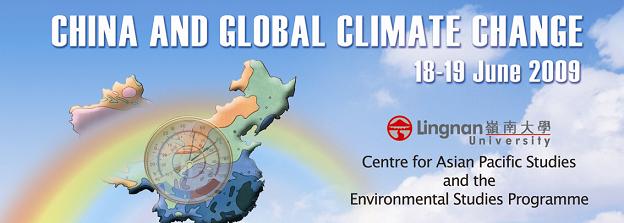
Event Title
Conference on China and Global Climate Change : Reconciling International Fairness and Protection of the Atmospheric Commons
Location
AM308, Lingnan University
Start Date
19-6-2009 11:00 AM
End Date
19-6-2009 12:30 PM
Language
English
Description
According to the controversial “environmental Kuznets curve” –hypothesis (EKC), some pollution would follow an inverted U-curve related to incomes, increasing at low income levels and decreasing at high income levels. Mohan Munasinghe argues (in a gerschenkronian way): “that developing countries could learn from past experiences of the industrialized world by adopting measures which would permit them to ´tunnel´ through the EKC, providing a possibility to avoid the most serious damage to the environment by avoiding the peak before a downturn of the emissions...” In our presentation, which is based on a comparison of Denmark’s, Finland’s, Sweden’s and Switzerland’s carbon dioxide emissions; we will examine China´s possibility to tunnel through its emissions of carbon dioxide.
With cumulative carbon dioxide emissions over the period 1870–2003 half that of Denmark’s or two thirds of Finland's or Sweden’s, Switzerland seems, at a first glance, to be a fine example of a munasinghean policy tunnel. Switzerland’s carbon dioxide emissions per capita were, however, in 2003 around 30 thirty per cent higher than global average and up to fifty per cent higher than those of China. As, in fact all industrialized countries are emitting carbon dioxide in quantities which can be considered well beyond their fair share of what can be considered as a sustainable global emissions level, there is at present no examples for developing countries to follow in order to tunnel through. Thus, our paper supports unilateral cuts in greenhouse gases, such as those agreed during the Spring Council meeting of EU heads of government in March 2007.
The attractiveness of the Swiss model depends also whether nuclear energy is considered desirable. The Chinese Three Gorges Dam – project, displacing over a million people, also shows that even hydro power can create large problems. If China would consume as much electricity per capita as Switzerland and produce it with the same means, this would require around sixty three gorges dams with an capacity of 85 TWh/a and six hundred medium sized nuclear power plants producing 7 TWh/a. In other words, China would need to build more new nuclear power plants than is at present in the world in total. It is also questionable whether a Swiss development path is possible worldwide, as its low energy consumption is due to a production of highly specialized and expensive products. At least it is not achievable with present consumption patterns in developed countries.
Document Type
Discussion
Recommended Citation
Kunnas, J., & Myllyntaus, T. (2009). Are there policy tunnels for China to follow? In China and global climate change: Proceedings of the conference held at Lingnan University, Hong Kong, 18-19 June 2009 (pp. 401-412). Centre for Asian Pacific Studies and the Environmental Studies Programme, Lingnan University, Hong Kong.
Included in
Are there policy tunnels for China to follow?
AM308, Lingnan University
According to the controversial “environmental Kuznets curve” –hypothesis (EKC), some pollution would follow an inverted U-curve related to incomes, increasing at low income levels and decreasing at high income levels. Mohan Munasinghe argues (in a gerschenkronian way): “that developing countries could learn from past experiences of the industrialized world by adopting measures which would permit them to ´tunnel´ through the EKC, providing a possibility to avoid the most serious damage to the environment by avoiding the peak before a downturn of the emissions...” In our presentation, which is based on a comparison of Denmark’s, Finland’s, Sweden’s and Switzerland’s carbon dioxide emissions; we will examine China´s possibility to tunnel through its emissions of carbon dioxide.
With cumulative carbon dioxide emissions over the period 1870–2003 half that of Denmark’s or two thirds of Finland's or Sweden’s, Switzerland seems, at a first glance, to be a fine example of a munasinghean policy tunnel. Switzerland’s carbon dioxide emissions per capita were, however, in 2003 around 30 thirty per cent higher than global average and up to fifty per cent higher than those of China. As, in fact all industrialized countries are emitting carbon dioxide in quantities which can be considered well beyond their fair share of what can be considered as a sustainable global emissions level, there is at present no examples for developing countries to follow in order to tunnel through. Thus, our paper supports unilateral cuts in greenhouse gases, such as those agreed during the Spring Council meeting of EU heads of government in March 2007.
The attractiveness of the Swiss model depends also whether nuclear energy is considered desirable. The Chinese Three Gorges Dam – project, displacing over a million people, also shows that even hydro power can create large problems. If China would consume as much electricity per capita as Switzerland and produce it with the same means, this would require around sixty three gorges dams with an capacity of 85 TWh/a and six hundred medium sized nuclear power plants producing 7 TWh/a. In other words, China would need to build more new nuclear power plants than is at present in the world in total. It is also questionable whether a Swiss development path is possible worldwide, as its low energy consumption is due to a production of highly specialized and expensive products. At least it is not achievable with present consumption patterns in developed countries.

